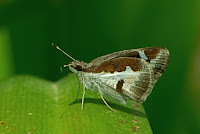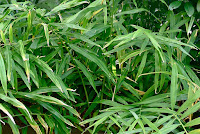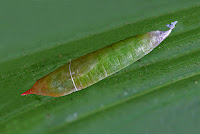<> Ancistroides folus (Cramer, 1775) <>
the Grass Demon ผีเสื้อพญาทุ่งหญ้า
Click on any photo to see all photos full size in Lightbox
Additions and corrections to the information provided on this page is always welcome. Please use the Contact form.
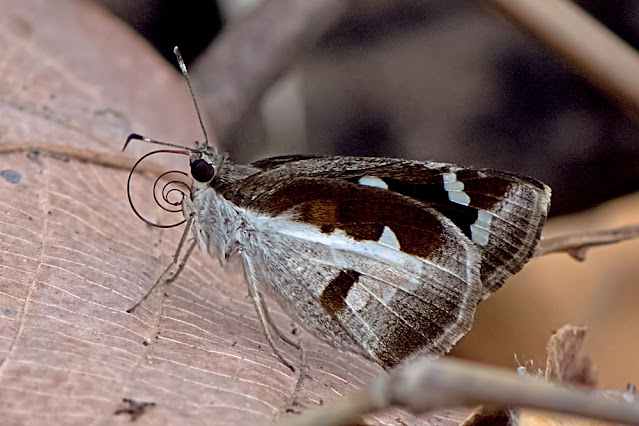
Photo taken at Doi Suthep-Pui National Park, Chiang Mai, Thailand. 460m a.s.l.

Ancistroides folus is fairly common throughout most of the Southeast Asia region. The sexes are very similar in appearance and behaviour so it is very difficult to determine the sex in the field. It flies close to the ground and the flight is rather erratic. It prefers dappled shade rather than direct sunlight and can often be found hiding under brambles or other scrub. When it needs to bask it does so on the leaves of herbs or shrubs with its hindwings pressed flat against the surface of the leaf and its forewings held half open at an angle above the hindwings. Both sexes visit flowers and have a very long proboscis enabling them to get to the nectar of flowers with long corolla tubes.
The species is multivoltine with several generations per annum. The adult female lays her eggs singly on the upperside of a leaf on the host plant. After hatching the larvae consume the eggshell as their first meal. They then feed on the leaves and live in shelters constructed by cutting and folding leaf fragments and securing them with silk. During the day it rests within the shelter and only ventures out to feed at night.
Synonyms and previously used names: Udaspes folus, Hesperia cicero
Taxonomy: Animalia - Arthropoda - Insecta - Lepidoptera - Hesperiidae - Hesperiinae - Ancistroides - folus
Regional subspecies: No subspecies are listed under this species.
Regional Distribution: Nepal, Bhutan, India, Bangladesh, Myanmar, Thailand, Laos, Cambodia, Vietnam, China, Taiwan, Malaysia, Singapore, Indonesia
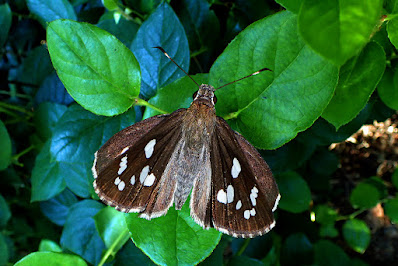 |
| Kbal Spean, Siem Reap, Cambodia 220m a.s.l. |
Habitat: Ancistroides folus is found in evergreen and deciduous secondary and montane forest. It prefers the forest edges or clearings where there is dappled light. It sometimes visits urban parks and gardens in search of nectar and has been recorded up to 2000m a.s.l.
Flight time: all year, depending on location Wingspan: 37-48mm
Life History: egg 3-4 days instar 1 2-3 days instar 2 2-3 days instar 3 3 days instar 4 4 days instar 5 6 days pupa 8 days Total egg to adult 28-31 days
All times are approximate and can vary depending on the season and on the host used.
Larval Hosts: Alpinia calcarata, Alpinia formosana, Alpinia intermedia, Alpinia japonica, Alpinia zerumbet, Curcuma amada, Curcuma angustifolia, Curcuma aromatica, Curcuma caesia, Curcuma pseudomontana, Curcuma longa, Curcuma oligantha, Curcuma zedoaria, Etlingera elatior, Hedychium coronarium, Kaempferia galanga, Zingiber montanum, Zingiber nimmonii, Zingiber officinale, Zingiber spectabile, Zingiber zerumbet (Zingiberaceae), Costus lucanusianus, Hellenia speciosa (Costaceae), Phoenix loureiroi (Arecaceae), Utania racemosa (Gentianaceae), Microstegium fasciculatum, Miscanthus sinensis, Oryza sativa (Poaceae).
Actual host plant used depends upon location and availabilty of plant species.
Adult Food Sources: Nectar - Duranta erecta, Lantana camera, Stachytarpheta jamaicensis (Verbenaceae), Catharanthus roseus, Tabernaemontana divaricata (Apocynaceae), Hedychium coronarium (Zingiberaceae), Hellenia speciosa (Costaceae), Jasminum multiflorum (Oleaceae), Hymenocallis littoralis (Amaryllidaceae), Mussaenda frondosa (Rubiaceae), Bidens pilosa, Chromolaena odorata (Asteraceae), Clitoria ternatea (Fabaceae). Other - bird droppings, rotting flowers.
 |
| Kbal Spean, Siem Reap, Cambodia |
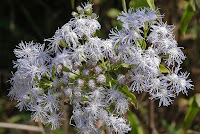 |
| Chromolaena odorata, a nectar source |
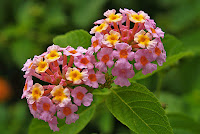 |
| Lantana camara, another nectar source |
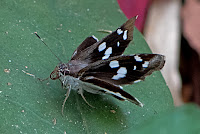 |
| Doi Suthep-Pui National Park, Chiang Mai, Thailand |
 |
| Hedychium coronarium, a larval host |
 |
| mid-instar larva |
Links to other pages in this series for species in the same subfamily

